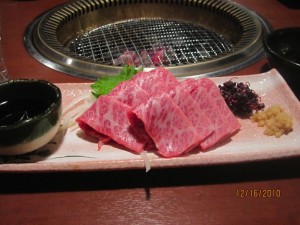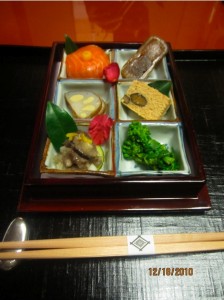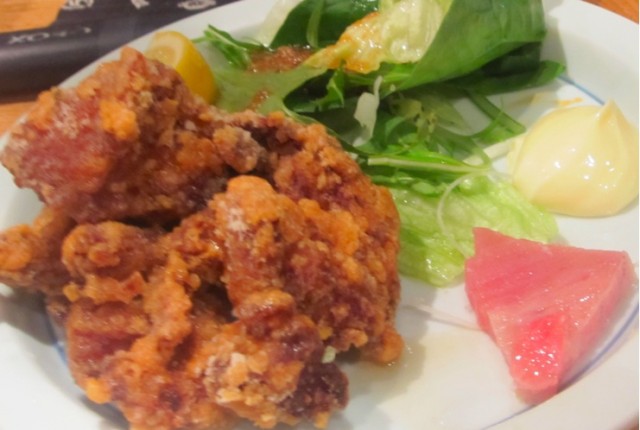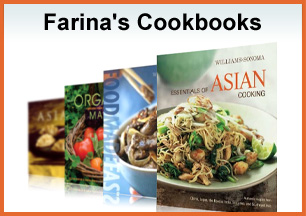Happy New Year! It’s been a busy yet fun-filled holiday. My husband and I have finally figured out that the only way to make the overseas flight from Singapore to San Francisco bearable is to break up the trip and explore a fun place along the way…this time Kyoto was our city of choice.
The brisk weather in Kyoto was a refreshing change to Singapore’s consistent tropical 85ºF. An excellent choice for being a tourist, Kyoto has beautiful world heritage sites, great Christmas shopping, and some of the best Japanese food we ever tasted.
The original imperial capital of Japan for more than 1,000 years, Kyoto is a perfect blend of old and new. From its subtle architecture, to the eclectic shopping and selection of amazing food, there is something for everyone. So civilized and extremely bike-friendly, it is the ideal city for exploration. We cycled the city’s major boulevards, visiting Buddhist temples and beautiful gardens and venturing through narrow residential alleyways lined with cozy tea rooms, home-style restaurants and small shops selling everything from traditional handmade leather slippers to beautiful wares for decorating family shrines. In the late afternoons in the Gion area, we were even fortunate enough to catch a few Maikos (Geishas in training), scurrying from one teahouse to the next.
Needless to say, our daily schedule was based on where to eat our next meal. Kyoto is a city of four seasons with endless monthly festivals and celebrations with wonderful shops selling traditional prepared foods and the best seasonal fresh produce and meats. We sadly missed the fall foliage, but arrived in time to try some classic belly-warming winter dishes. Kyoto is a haven for viewing incredible food presentation and sampling tasty treats. One day we ventured through Kyoto’s open air Nishiki Market with its endless fresh seafood and pickled vegetable vendors, then we squirreled our way to the basement of Takashimaya department store to savor all the artfully prepared foods.
We all yearned to sit down to a cozy meal each day after our long bike rides. Fortunately, our friends recommended a range of home-style restaurants specializing in dishes of Kyoto to choose from. One of our stops was at HONKE OWARIYA, a charming noodle shop in a 500-year-old beautiful wooden house. We had the most delicate soba noodles with paper-thin slices of roasted pork. Later in the evening we stopped at ICHISHUN, a fun pub-like neighborhood restaurant for some of the tastiest kaarage (crisp season fried chicken), perfect with cold draft beer.
The following day, we had to get our beef fix at a yakiniku restaurant called HIRO, where we started with incredible slivers of beef sashimi followed by slices of insanely marbled beef from the southern island of Kiroshima. We grilled the beef at our table for just several seconds and savored the meat with pickled mountain vegetables and rice.
But the meal of all meals was the winter 11-course kaiseki dinner at the infamous restaurant KIKUNOI, tucked away in the foothills of Eastern Kyoto. From the tasteful architecture and impeccable service to the care of each artfully presented dish, we left feeling in total awe of the art of Japanese cooking.
Our short stay in Kyoto was just a brief introduction to the commitment and sense of pride the Japanese have in their culture. Entrenched in history and tradition, Kyoto is one of the few Asian cities where I have witnessed a society that has utmost respect for the preparation and presentation of their food. Integrating the best culinary techniques and styles of other countries, Japan has always maintained their unique culinary identity.
As always, I feel the best way to share my travel experiences is to write about my adventures and to share a memorable dish from the region. Enjoy my version of this kaarage recipe and don’t forget to put Kyoto on your list of places to visit.
This recipe is a variation of Kaarage from ICHISHUN restaurant. Try serving this as an appetizer or as an entree with a salad and white rice.
Kaarage – Japanese fried chicken
1 1/2 lb boneless chicken thighs, skin remove
2 tablespoons cornstarch
1/4 teaspoon kosher salt
Marinade
2 tablespoons mirin
2 tablespoons grated ginger
2 cloves minced garlic
3 stalks green onions, white parts only
1 tablespoon light soy sauce
1/2 teaspoon sugar
1/8 teaspoon white pepper
canola oil for frying
1 lemon cut into wedges
1/4 cup mayonnaise (optional)
Cut the chicken thighs into 3 inch pieces and place in a non-reactive bowl.
In a blender or mini-food processor, combine the marinade ingredients and blend to form a smooth paste. Pour the marinade over the chicken pieces, mix well, cover with plastic wrap and refrigerate for 30 minutes.
Preheat an oven to 200ºF. To fry, fill a wok or heavy bottom pan with 3 inches of canola oil and heat over medium-high to 365ºF.
Right before frying, remove the chicken from the refrigerator and drain off excess marinade from the chicken. Stir 2 tablespoons of cornstarch and 1/4 teaspoon of salt in to the marinated chicken and mix well. Once the oil is hot, carefully slide 5 to 6 pieces of chicken into the oil. Use a skimmer to move the chicken back and forth and let fry until crisp and golden brown, about 1 to 2 minutes. Transfer to a paper towel lined sheet pan. Allow the oil to reheat and fry the remaining chicken pieces. Place the fried chicken in the oven to keep warm.
Serve the fried chicken hot with wedges of lemon and a dollop of mayonnaise.






